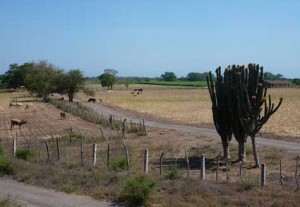Kristian Beadle underscores the effect drug cartels are having on Mexico’s politics, people and ultimately, its environment.
Location: Near the Zona Dorada in Mazatlán, the hub of tourist pleasure.
Conditions: The breeze and cool ocean water wash off the hot, muggy air of the city.
Someone asked me in California, “You’re writing about the environment in Mexico? I bet people are more worried about the drug war and staying alive.” I would come face to face with this issue once I arrived in the mainland.

Like an absurd nightmare, the guy’s face appeared everywhere you looked in Mazatlán — on every street post, plastered on cars, billboards and buses. Like it was relentlessly stalking you, the advertising campaign for candidate Jesus Vizcarra, running for governor of Sinaloa (the elections were July 4th) gave new meaning to the word omnipresent. “As you eat lunch at the restaurant, you might discover his face on the plate through the rice and beans,” laughed Edgar, a surfer I met on the beach. How in heaven is so much money spent on ads?
“It’s no secret: It’s the narcos,” said Edgar, referring to narcotraficantes, the drug lords of Mexico. A photo published by the newspaper Reforma showed the candidate Vizcarra next to a high-ranking member of the Sinaloa drug cartel, one of the cradles of Mexican drug trafficking. Some people were outraged; others shrugged it off and justified, “We need someone who can negotiate with the narcos and bring us peace.”
The largest cocaine consumer in the world is the U.S., and 90 percent of it goes through Mexico, according to a 2008 State Department report. Millions of pounds of marijuana are produced for export, which by some estimates is the most profitable product for drug cartels. Heroin and methamphetamines are also major trades. On the flip side, most guns used by drug cartels come from America, since Mexico has tight gun laws, funding a very profitable arms trade. Almost every snort, injection and puff in the U.S. directly funds the drug cartels in Mexico. This backwash of dirty money is disintegrating the country’s social fabric and environment.
Edgar and I paused to watch the waves peel into the bay, next to a castle-like discotheque perched on a rocky point. In the distance, the 10-story resort hotels of Mazatlán dotted the beaches. Far behind us, narrow roads cut through steep hillsides leading to the busy port. Mazatlán feels relatively safe, but there are some oddities. Edgar started telling me about a famous surf spot north of town, which is now off-limits due to a shady surf camp.
“It is a gift of nature, one of the best waves in Mexico. It used to be a quiet ranch, but now the surf camp fenced it off. The last time my friend parked in the nearby town and hiked in to surf, his car tires were slashed. They are protected by the mafia, the narcos, so we can’t do anything about it. Not worth getting killed over, you know?” Having an exclusive surf playground for rich gringos is a disgrace; but if it’s indeed protected by drug money, consider it a minor symptom in the disease sweeping through the country.

The United Nations estimates that the North American market for cocaine alone is a $37 billion-a-year business, not counting marijuana, heroin and methamphetamines. For drug traffickers and drug users, it is a blessing that the United States shares a 2,000-mile border with Mexico; for everyone else, it’s turning into a curse. Since 2006, when President Felipe Calderon intensified the war on drugs, about 25,000 people have been killed. In Ciudad Juarez alone, a key trafficking route on the U.S.-Mexico border, 1,200 people were murdered last year (as a comparison, consider that the entire coalition in Afghanistan has suffered 1,910 fatalities in nearly 10 years). Recently, to facilitate their operations, drug cartels have been emptying border towns by terrorizing residents and forcing their relocation.
The government’s attack on the drug cartels, with thousands of military personnel assigned to the battle, has escalated the violence. Killing and incarcerating drug lords has only managed to create power vacuums, which other rival gangs attempt to fill with unpredictable consequences. When one of the nation’s most-wanted drug lords, Arturo Beltran Leyva, was killed in a shootout led by the Mexican Navy in December 2009, many applauded the effort. However, the biggest winner was his archrival from the Sinaloa cartel, Joaquin “El Chapo” Guzman, who has landed on the Forbes magazine billionaire list as richest man No. 701 and 41st most powerful man in the world.
Recent news from Mazatlán has been stunning. In a prison near the city in mid-June, armed inmates from the Sinaloa cartel executed members of the opposing Zeta cartel, who were locked in a confined area; 29 people died before prison guards controlled the situation. Then, like a slap in the face, the election last Sunday saw the candidate Vizcarra lose the Sinaloa governorship by a narrow margin, supposedly marred by his association with the cartel.
The democratic process wasn’t nearly as exemplary around the rest of the country. One week before the election, a candidate in the state of Tamaulipas was shot dead, presumably for making a campaign promise of enhanced security in the region. Many election polls did not open due to worker fears, and the voter turnout was extremely low. The day after the election, a cartoon from the newspaper La Jornada captured the nation’s sentiment showing two citizens talking about their ballots, asking, “Which cartel did you vote for?”
For decades the United States pressed Mexico to do its share in the war on drugs. Now that the Mexican government has taken the plunge, chaos has ensued. Fewer tourists are coming to Mexico, feeding the downward poverty spiral that strengthens the desperate drug machine. The United States has contributed billions of dollars to Calderon’s war on drugs, with support from the Obama administration.
Meanwhile, a U.S. military report has named Mexico — along with Pakistan — as countries to monitor for potential collapse. Even if the ‘civil war’ on Mexico’s drug cartels subsides, there are long-term consequences many people aren’t even aware of. Namely, the enormous destruction of the environment caused by drug production, a subject to be addressed in the next post. The great illusion is that Americans are flying high (in more ways than one) and Mexicans are crawling on their knees — but the reality is that we’re all skating on thin ice.




